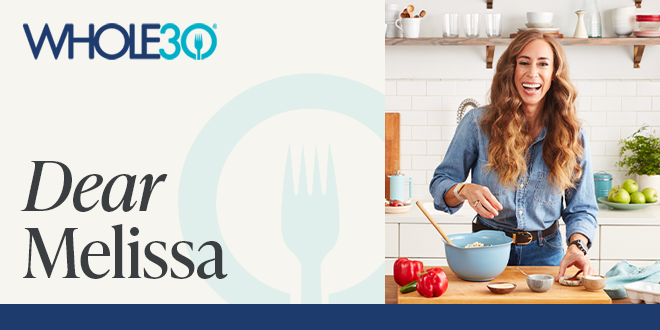Dear Melissa,
I’m on Day 14/17/21 of my Whole30. Some things are feeling better, but not as good as I’d have hoped. I feel like I’m missing out on the “Whole30 magic.” Help? -Lots of you
Dear Whole30ers,
I hear you, and I want to provide some reassurance first. There is no universal Whole30 experience. Some people wake up on Day 14 feeling like they’ve flipped a switch into “Energizer Bunny mode.” Others feel more subtle or gradual shifts through the last half (or in the last week) of their Whole30. Though these shifts are starting to take place under the surface (blood sugar regulating, gut health improving, brain patterns rewiring, inflammation calming), it takes time for them to make their way to the surface. You may not yet notice your energy, sleep, digestion, cravings, or symptoms have dramatically improved, but have faith that your body is doing the hard work to repair, restore, and rebalance.
We used to call this phase “Whole30 tiger blood.” We changed it because, besides feeling dated, that phrase didn’t represent the breadth and depth of experiences during the last half of the program. There are so many factors that play into your Whole30 experience. Your eating habits and dieting history before the Whole30, chronic health conditions, lifestyle, stress levels, age, medications, social support, and genetics all factor in here. For some, the “Whole30 magic” shows up quietly and without flash, but in a way that feels sustainable and long-lasting. For others, it shows up quickly and suddenly, like a night and day transformation. Progress may appear in some areas, but not others. You may experience unexpected benefits, while that one thing you were really hoping would happen hasn’t happened yet.
Sometimes, not feeling the “magic” is simply about adjusting your expectations. Don’t compare your Whole30 to anyone else’s, or your own in the past. Release expectations about what you “should” be experiencing, and stay present in the moment and in your body. Focus on what is changing, because the more you do that, the more your brain will look for evidence that it is working. And lean on your support system, because they can likely point out benefits you hadn’t even noticed.
Having said that, if your expectations are well-managed and you still feel like you’re missing out, there are some practical things you could examine. These factors may be holding you back from feeling as good as you could, and some of them are quick and easy to adjust.
Factor #1: Not eating enough
If your energy isn’t high or steady, your workouts are dragging, or your focus is meandering, you may not be eating enough. Specifically, enough carbohydrate. It’s common for people to under-eat on the Whole30, and it tends to catch up with them towards the end of the second week (or in the third). You’re probably eating lots of nutrient-dense veggies (leafy greens, broccoli, cauliflower) but they’re not very energy-dense. And maybe you’re still afraid of dietary fat, unwilling to add more than a sliver of avocado to any given meal.
Depending on your activity levels, it’s possible that all you need is a bump in meal size, and/or more carbs, and/or more fat. If that’s the case, it’s a fast and easy fix. If you’ve been super low-carb and/or you’re very active, start adding some starchy veggies (potatoes, winter squash, beets) and whole fruit to every meal.
If you’re on the lower end of our dietary fat recommendations (regardless of activity levels—everyone needs to eat at least the minimum!), add a little more to each meal. You don’t have to quadruple your portions; try an extra pour of dressing, or half an avocado instead of a quarter. If you start feeling better, feel free to continue ramping this up slowly.
Note, many people think they’re getting enough fat because they add a tablespoon or two of cooking oil to the pan before roasting their veggies or frying an egg. But much of that oil is left in the pan, and you may be making 2-4 servings of food with that same amount of fat. If the added fat in your meal is just coming from cooking oil, I’m betting you’re not getting enough. Start adding an oil-based dressing or sauce, some mayo, olives, nuts and seeds, avocado, or coconut flakes to your meals and snacks.
If not eating enough is what’s holding you back, you’ll feel better in just a few days—sometimes immediately.
Factor #2: Life stuff
When people start the Whole30, they tend to make everything in their life about the Whole30. I have a headache—Whole30-related. My skin broke out—Whole30-related. I got a flat tire—damn you, Whole30. (It’s why I wrote a whole article called, “Is this normal?”) But step back and take a big-picture look at your life right now: Are there other lifestyle factors that could be impeding your progress here? I once went back and forth on Facebook with a woman who wasn’t feeling great, trying to troubleshoot. I could not figure it out… until she casually mentioned she was six months pregnant. Ma’am, that’s important information.
If you’re only sleeping five hours a night because of a new baby or puppy, under a ton of stress at work, pregnant or nursing, recovering from an injury, caregiving for a family member, or have been living with chronic illness (fatigue, pain, autoimmune), that will impact what you see with the Whole30. Dietary factors can bring tremendous improvements to stress levels, sleep, energy, and symptoms. However, it may take longer, and diet alone isn’t enough to compensate for big life challenges.
If this is your context, I encourage you to revise your expectations, and start looking for smaller victories. If you’re sleeping a little more deeply, handling your stress without comfort foods, noticing your cravings have diminished, or don’t feel as groggy after lunch, that is your Whole30 magic right there. And I’d venture to say those are huge victories, given the other factors you’re navigating. GIve yourself credit there!
Factor #3: Your mealtime habits
Here, I’m going to ask that you take a good, hard look at your Whole30. Not the technicalities (because I’m sure you’re following the Program Rules), but some of the nuance. It’s not against the Rules to eat two Larabars as a snack, eat dried mango or dates when you get cravings, or graze between 8 and 11 PM. But these behaviors may not be helping you find that Whole30 magic.
Are you still eating every 2-3 hours? Do you graze like a gazelle all day? Are you satisfying sugar cravings by immediately turning to dried fruit and nut butters? Do you skip meals or added fat because you worry you’re eating too much? These habits slid under the radar in Week 1, because your body was still dramatically adjusting. But at this phase in the program, they might be holding you back from getting into fat adaptation. That could leave you still riding the blood sugar roller coaster, and feeling the energy crashes, brain fog, and crankiness that results.
Adjusting this at this stage of the game might be rough for a day or two as you’ve only delayed the “hangover” stage of the Whole30 Timeline. However, you should adjust quickly, and that Whole30 magic could be right around the corner once you do!
Factor #4: Patience, grasshopper
Many people just need a bit longer for the magic to kick in. (It’s called the Whole30 for a reason.) Remember, you’re not done yet. If you’re noticing any progress, then you’re on the right track.
This is especially true if you have a history of chronic pain, fatigue, or an autoimmune condition. In that context, I’d not be surprised if it’s taking longer for you to start seeing the benefits. Your immune system has been overactive and reactive for a long time. In fact, with these medical conditions, it’s not unusual for symptoms to get a little worse (generally in the third week) before they start improving again. If this is your context, speak to your doctor towards the end of your 30-day elimination. They may recommend you continue with this phase for 45 or even 60 days. (Always follow your healthcare provider’s directions.)
The good news is that if you’re feeling better in some areas (energy, sleep, focus, mood, digestive stuff, pain, or seeing even a small improvement in other symptoms) it’s confirmation that you’re on the right path. See where you are at 30 days, then decide if going a little longer is the right decision for you. If things are getting better, even slowly, that’s a great sign, and you have plenty of time to see even more impact.
The last word: Context matters
The last word: Sometimes, people don’t think they’re feeling that much better until they start feeling worse again. Like, you’ll get to Day 31 and think, “I feel better but nothing ah-mazing,” but then you start to reintroduce and you’re all “OMG THIS FEELS LIKE CRAP! Is this (tired, foggy, craving, achy, blotchy, bloated, sluggish) really how I used to feel?”
Sometimes, you need the comparison for clarity. Just something to think about as you head into the back half of your Whole30.
Whole30 magic in 3, 2, 1…
Whether it’s redefining your idea of “magic,” making some tweaks to your Whole30 meal plan, or being more patient, one thing is certain: Your Whole30 experience is changing your health, habits, and relationship with food! Stay focused on the positive benefits you are seeing, and let go of any preconceived notions of what this day of your program should look like. The fact that you’re still here working hard to change your life is one NSV each and every one of you can check off today!
Best in health,
Melissa














